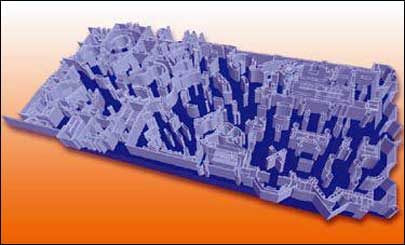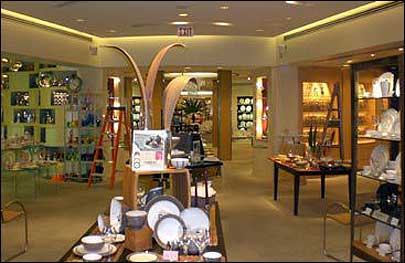Aug 08, 2008William Ashley is no everyday retailer. The Canadian purveyor of high-end china, crystal and other tableware is all about customer service. At the company's flagship, 24,000-square-foot showroom on Toronto's Bloor Street, up to 60 salespeople tend to customers, who need not worry about carting purchases around the store. Showcases throughout the sales floor display samples of the retailer's huge inventory of plates, bowls, silverware and vases that make up the 550,000 SKUs it sells.
When a customer is ready to make a purchase, a salesperson runs an inventory check for the items via one of the store's 60 computer stations. Assuming the desired items are in stock, this sets a number of transactions in motion, resulting in the employee handing the wrapped purchases directly to the patron, or having them loaded into the customer's car. To speed the process of bringing the goods to the purchaser—and to improve other store business processes as well—the retailer has installed a Ubisense real-time location system (RTLS).
Battery-powered Ubisense tags emit a series of short signals (billionths of a second or shorter) at frequencies between 6 and 8 GHz. According to Ubisense, the extremely short nature of these pulses makes them less vulnerable to RF interference from objects and other RF noise, relative to conventional RFID real-time locating systems. Once a reader—or Ubisense Sensor—receives a tag's signal by means of a phased array antenna, it calculates the tag's location by employing two complementary techniques: time difference of arrival (TDOA) and angle of arrival (AOA).
William Ashley partnered with Toronto-based IT systems developer DSI to select, test and deploy the Ubisense system at its Bloor Street location. The company is now preparing to roll out the system at its second retail location as well.
When a salesperson processes a customer's order, an electronic picking list is generated and a hard copy is printed in the store's stock room, where an employee pulls requested items from inventory and sends them, via a conveyor, to a quality-assurance agent. That agent inspects the items for damage, cleans and packages them, and places them on a conveyor leading to a designated area, where another worker—known as a runner—collects the packaged goods and brings them to the salesperson on the floor who requested them. The Ubisense technology is used, in combination with an audio-based directional system, to help the runner quickly locate the appropriate salesperson on the sales floor.
To accomplish this, a Ubisense transponder is integrated into a name tag worn by each runner and salesperson. The printed picking list accompanies each package a runner receives from the quality-assurance department. At a computer station, the runner scans a bar code printed on the list, prompting the Ubisense readers, mounted throughout the store, to determine the location of the salesperson who initiated the order. The Ubisense system can pinpoint a salesperson's location to within 1 foot of accuracy, according to Norm Tomlins, DSI's general manager.
Once the salesperson's whereabouts is determined, the Ubisense system transmits the location data to a Unix-based software tool that DSI customized for William Ashley. This software then transmits audio directions to the runner via an earpiece, updating them constantly, to track the salesperson's movements throughout the store. To lead the runner to the correct salesperson, the audible directions cite departments—and zones within those departments—by name.
Previously, William Ashley utilized a different RFID-based RTLS that also employed transponders integrated into name tags. But that system, according to a DSI representative speaking on Tomlins' behalf, could locate a person only to within 20 feet, and its accuracy was eroded when a salespeople was in motion. Because the store has numerous large displays and partitions on its sales floor, runners often could not make visual contact with the salespeople they sought, even when standing within 20 feet of them. The greater location accuracy of the Ubisense system, the company claims, reduces that problem.

In addition to aiding runners, the Ubisense system is helping salespeople communicate with each other by leveraging a two-way communication function integrated into the tags. As a salesperson helps one customer, one or more other patrons may also require assistance. By pressing a button on the Ubisense tag, that employee can send out a call for assistance to other staff in the store.
The other salespeople receive this request via a short audio alert emitted by their own badge's Ubisense tag. An available salesperson walks to the nearest computer station, keys in to accept the request and receives instructions regarding where to go in the store to locate the staff member who requested help. That worker's badge then emits a short audio signal to indicate help is on the way. The salesperson who requested help will often see the responding staff member walking into his department, make eye contact and simply nod in the direction of the customer needing assistance. This way, he never needs to leave the patron he is currently helping.
In addition, the retailer is utilizing the Ubisense system for two other applications: tracking time and attendance, and controlling access to 150 display cabinets on the sales floor.
Upon entering the store, each staff member picks up his or her RFID-enabled name badge from a central location, then stands in front of a computer monitor, where a nearby Ubisense reader picks up the tag's signal. The reader then forwards that person's ID to the retailer's time and attendance software, provided by DSI. This software determines, based on the employee's schedule, that the individual is there to begin a shift. It clocks the worker in, prompting the person's name to appear on the computer screen, along with an automated audio greeting. The staff member stands in front of the monitor to clock off and back on when it's time for a break or lunch, then later clocks out at the end of the shift.
To access a display cabinet on the sales floor, a salesperson pushes a button on his Ubisense tag and, within three seconds, presses on the spring-hinged cabinet door. The door's electronic lock will disengage, and the security system will know which employee has opened the cabinet—which the retailer can compare with surveillance video recordings at a later date, if necessary. If anyone attempts to open a cabinet without first pressing the correct name-tag button, the cabinet will not unlock.


